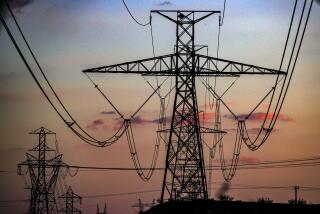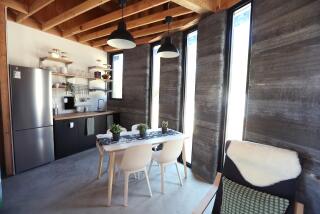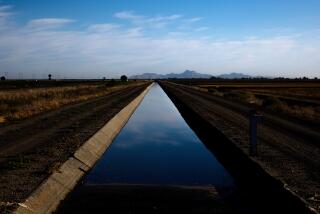Edison Powers Up New Facility Demonstrating Energy-Saving Devices
A state-of-the-art energy conservation facility that includes a “house of the future” opened in Irwindale to favorable reviews Monday from public officials, environmentalists and scientists.
But while the gadgets and gizmos meant to demonstrate energy-saving techniques might once have seemed futuristic or startlingly Space Age, today they are familiar:
In a room oriented toward conservation applications for businesses, there was an industrial-size microwave oven for short-order processing of products from pickles to dog food. Parked in a driveway was a white electric-powered van with its batteries on display.
Nearby, an electric commercial kitchen oven turned out pizzas in five minutes--two-thirds the usual cooking time.
“It’s beautiful. It cooks real fast, and the food tastes no different,” said Alfonso Martinez, a chef on loan from a nearby pizza restaurant, as the smell of baking dough filled the air.
On display in yet another room were light bulbs that last 10 times longer than conventional ones--and cost from $12 to $16 each. However, officials said the bulbs more than pay for themselves in the long run.
The $4-million facility’s purpose was summed up by Southern California Edison Co. Chairman Howard P. Allen, who said, “Here customers can learn firsthand how to conserve energy and reduce energy costs without sacrificing comfort or convenience or healthful air quality.”
Another official described the 23,000-square-foot building as “the largest and best equipped facility of its kind in the United States.”
He received no argument from a host of public officials, scientists and environmental experts, such as Ralph Cavanagh of the Natural Resources Defense Council and Art Rosenfeld, a UC Berkeley physicist.
Yet internationally known environmental futurist Armory Lovins, who attended the unveiling of the facility, pointed out that the United States lags behind such nations as Japan in conservation measures. Japan, he said, “uses 50% less energy than America to produce $1 worth of product, and that gap is widening.”
“This facility helps do something about that. It’s full of reasons for optimism that we can do much better,” Lovins said.
Edison created the facility after prodding by environmentalists and state Public Utilities Commission members who are concerned that California is back-sliding in the area of energy conservation. Allen acknowledged that the pressure was part of the reason Edison built it.
“We don’t have all the answers,” Allen said. “This is an everybody-wins facility. We’re committed to helping the officials in this area improve the air quality which is a major problem for the people of this basin.”
Edison invited a host of business, environmental, press and governmental guests to the facility’s unveiling. Members of the general public may sign up for group tours, but the facility is geared primarily to Edison’s commercial customers, a company spokeswoman said.
Allen noted that the facility has an industrial room where special furniture manufacturing ovens are on display. Because the energy-saving ovens use ultraviolet light, they can dry high-tech wood finishes without giving off the pollutants engendered by the usual varnishing process.
Southern California’s furniture industry, cited as a culprit in air pollution, is struggling to meet strict air quality rules.
Officials said many of the new appliances on display are expensive--but worth it.
“What we’re saying is there is a different and better way,” said Edison research manager Geoff R. Bales as he stood before a bank of energy-efficient light bulbs. “These are state of the art, and we believe they are being underutilized. It will cost a little more, but it will pay for itself.”
More to Read
Sign up for Essential California
The most important California stories and recommendations in your inbox every morning.
You may occasionally receive promotional content from the Los Angeles Times.









